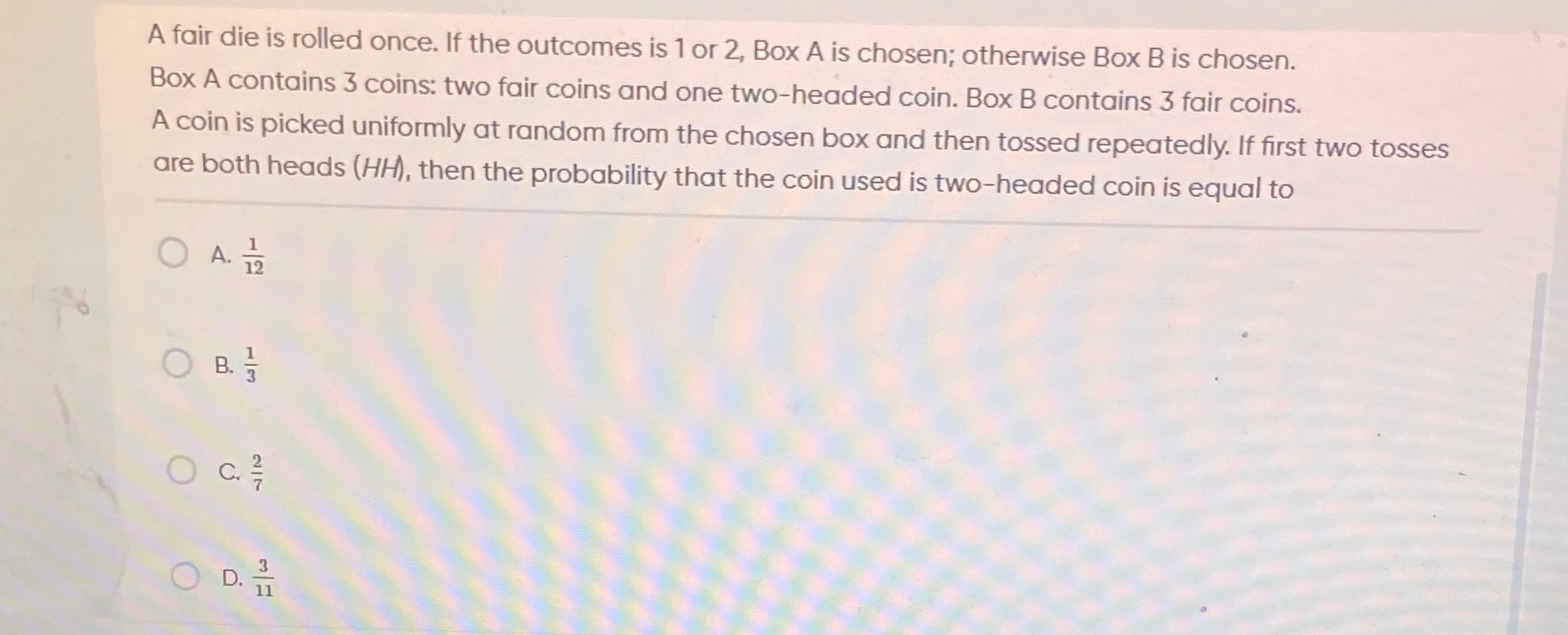Question
Question: A fair die is rolled once. If the outcomes is 1 or 2, Box A is chosen; otherwise Box B is chosen. Bo...
A fair die is rolled once. If the outcomes is 1 or 2, Box A is chosen; otherwise Box B is chosen. Box A contains 3 coins: two fair coins and one two-headed coin. Box B contains 3 fair coins. A coin is picked uniformly at random from the chosen box and then tossed repeatedly. If first two tosses are both heads (HH), then the probability that the coin used is two-headed coin is equal to

121
31
72
113
31
Solution
-
Probabilities of choosing boxes:
- Let A be the event that Box A is chosen, and B be the event that Box B is chosen.
- P(A)=P(die shows 1 or 2)=62=31.
- P(B)=P(die shows 3, 4, 5, or 6)=64=32.
-
Probabilities of choosing coin types from each box:
- Box A: Contains 2 fair coins (CF) and 1 two-headed coin (CTH).
- P(CF∣A)=32.
- P(CTH∣A)=31.
- Box B: Contains 3 fair coins (CF).
- P(CF∣B)=33=1.
- P(CTH∣B)=30=0.
- Box A: Contains 2 fair coins (CF) and 1 two-headed coin (CTH).
-
Prior probabilities of using each coin type: Let CTH be the event of using a two-headed coin, and CF be the event of using a fair coin.
- P(CTH)=P(CTH∣A)P(A)+P(CTH∣B)P(B)=(31)(31)+(0)(32)=91.
- P(CF)=P(CF∣A)P(A)+P(CF∣B)P(B)=(32)(31)+(1)(32)=92+96=98.
-
Probabilities of observing HH given the coin type: Let E be the event that the first two tosses are both heads (HH).
- P(E∣CTH)=1×1=1 (A two-headed coin always lands heads).
- P(E∣CF)=(21)×(21)=41 (A fair coin has P(H)=1/2).
-
Apply Bayes' Theorem: We want to find the probability that the coin used is two-headed, given that the first two tosses are HH, i.e., P(CTH∣E). Bayes' Theorem states: P(CTH∣E)=P(E)P(E∣CTH)P(CTH) First, calculate the total probability of observing HH, P(E), using the law of total probability: P(E)=P(E∣CTH)P(CTH)+P(E∣CF)P(CF) P(E)=(1)(91)+(41)(98)=91+368=91+92=93=31 Now, substitute the values into Bayes' Theorem: P(CTH∣E)=31(1)(91)=3191=91×3=93=31
